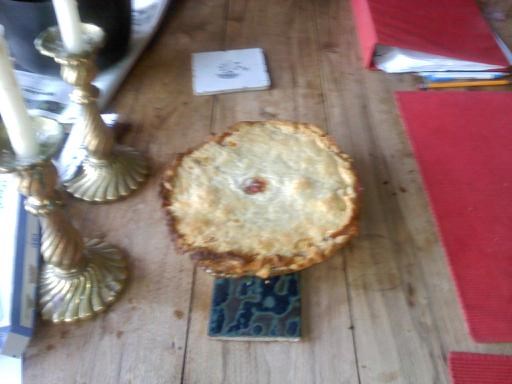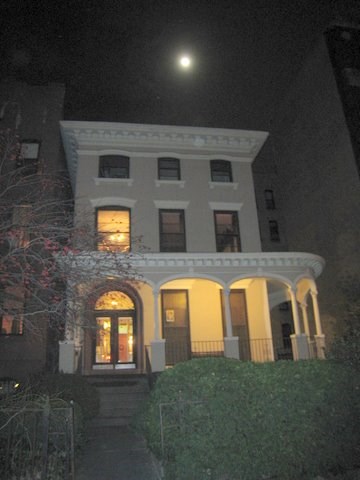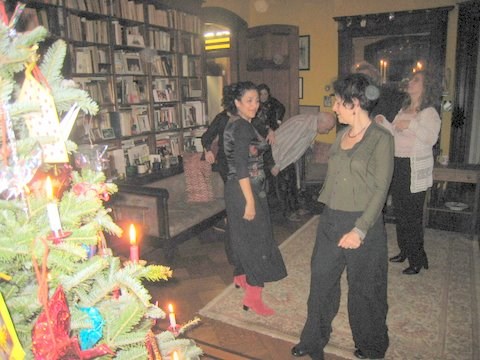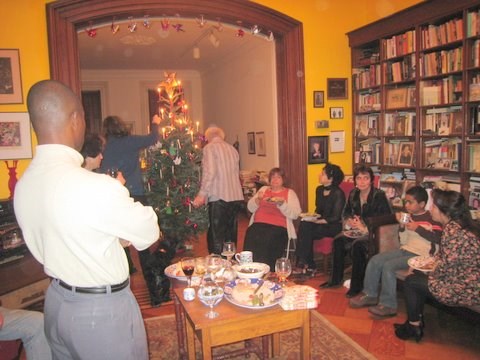
By Guest Blogger Karen Malpede
A cocker spaniel pup and an errant bullet ricocheting around the living room caused us to seek a new apartment closer to the ground and further from Myrtle Ave.
The garden duplex we rented in 1991 is in a free standing Italianate villa with a double lot. From the large bay windows in the huge kitchen we see into the Pratt campus and watch the changing seasons. The entrance hall is lined with posters from our plays designed by graphic artist Luba Lukova (I'm a playwright, my husband an actor; together we run a theater with offices in the house).

The wide-eyed, horned head of the large Yak-like puppet Basil Twist designed for a play peers from a high cupboard. The ceilings on the parlor floor are 14 ft high; there are pocket doors, two fireplaces with original mirrors. The built-in cherry wood bookcases are filled. A bronze statue of Nijinsky dances in the bay in the middle parlor we have painted Tuscan yellow.
There's an octagonal hand-crafted chandelier we bought outside Al Alzar Mosque, a side table I made with antique Italian tiles brought from Umbria. On a brass coffee table are two masterful ceramic dogs by the artist Susan Rowland, whom I met walking dogs in the park and who, with her husband the late Federal Judge Tony Sifton, was in our living room the night President Obama was first elected.
We joined the flood of neighbors into the streets to dance and cheer: "It's the first time I've seen Americans happy," the Bodega owner said the next day. The dog park hours were times for jokes and politics; several among us lost good jobs in 2008, including a Crain's business writer.
My daughter had the downstairs bedroom opening on the garden with a dogwood tree and ancient roses. I made my office in the little room with ground-level windows where I have written seven plays. We put our futon on the front parlor floor. Each Passover, for years, we rolled up our bed and set out snaking plywood tables for 80 or more.
We read through Judith Malina's telling of the Haggadah, heard the prayers in Hebrew and in Arabic, chorused Allen Ginsberg's "Holy". Always, our home has been a semi-public space: I interviewed local survivors of the 9/11 attacks in our living room for an oral history project while my husband and Danny Simmons were installing 8 original large paintings in the G-line subway station.
Our home has been a refuge for two fatherless Bosnian families, a student displaced by Hurricane Katrina, an Iraqi actor; Egyptian, Croatian, Macedonian, Syrian and local artists have danced at our Christmas Eve parties when, in honor of George's German family who hid him, we light real candles on the tree. We held Peace Salons during the run-up to the Iraq war. A Turkish rug sale for our theater turned the parlors into a souk. A benefit for Rabbis for Human Rights, a baby shower for a Palestinian human rights worker, rehearsals, and so much else has happened here.

But our home is not our house. Its owner, a retired banker living on Long Island, is currently taking private bids (5 to 6 million we guess) for her property which represents "a tidy nest egg" so she can '"live off the fruits of her labor."
We recognize ourselves among those fruits. Developers walk our streets offering homeowners a million and more, cash, sight unseen; if the offer is accepted as happened when a multi-generational black family decamped abruptly for Las Vegas, the house is put on the market days later for twice as much. The eccentrics, the artists, the black and Italian families who owned the homes for generations are disappearing, though some are also refinancing.
The new owners and renters, mainly white, lead corporate lives. They don't remember people like Bill Sikes who worked to landmark the district, hand crafted his house and with his wife, Lucy, a painter, sang in the Lafayette Presbyterian Church choir, a stop on the Underground Railroad.

They have never been to the Sikes' Christmas pot-luck where the rotund black director of that choir gets us to sing the Hallelujah Chorus, including our retired mailman, a tenor. They never heard the rhythms of the African dance in the basement of the Lutheran Church that's about to become a condo.
When did our affordable, quixotic neighborhood become property? The new owners across the street rent pricey Airbnb's, lease to film and photo shoots, sell dinners with young chefs. On the corner, a house once occupied by photographers has been carved into high-priced studios; the five family brownstone opposite is on the market. Said a realtor: "no one knows where the people will go."
I'm reminded of Jesse Jackson's remark: "The difference between the poor and the middle class is the down payment." In super-gentrified Clinton Hill, the difference between the displaced and the wealthy is having had that down payment in 1976, when our landlady bought this house for a song from an Italian family whose grapevine we have harvested one last time.
I'm going to make a pie.
Karen Malpede's newest play, "Extreme Whether," runs Oct 2 - Oct 26, at Theater for the New City. For information and tickets, visit www.theaterthreecollaborative.org.



